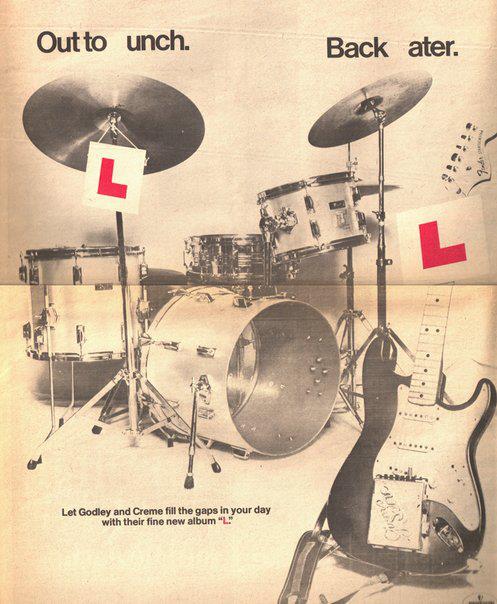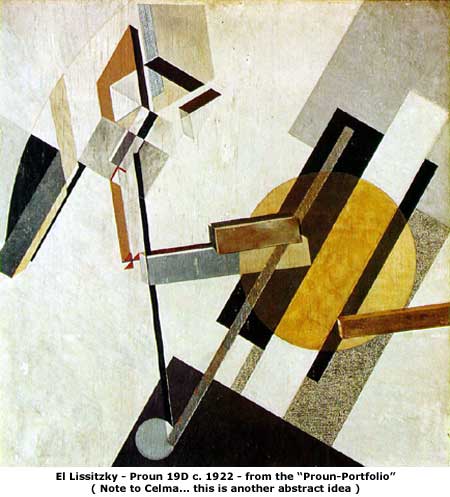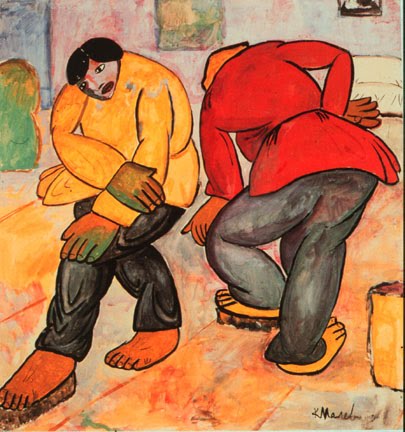There was a famous line attributed to Walter Benjamin that captures somewhat the problem the Nazi’s had with what they termed “degenerate art,” which lacked the necessary material underpinnings to easily transform itself into unchallenging kitsch. Benjamin’s “logical result of fascism is the introduction of aesthetics into politics,” meant the aestheticization of politics, could not occur without the role and complicity of art into the formation of fascism into something real. A bit like Drone weaponry design bearing a resemblance to Bauhaus style, and Bauhaus architects entrusted with the task of designing death camps. But even more pervasively, Hitler as art director with Himmler and Goebbels in this aesthetic project of making lies into myths and myths used to create truth. A turned into theater; the short jump of corrupting the “lie” that art tells, as storyteller, as transmitter of experience, in order to create or recreate, given birth from the artist’s imagination: Wagner and the Nazis being the predominant example.
The problem with degenerate art was that there were events outside the art world that sort of crashed the system, overload and overwhelming that could not be dealt with in the established figurative manner. Old certainties had been shattered, and for the Nazis, the “lie” being to take this evident inadequacy to connect with life, a denial and present it as a virtue. Narcissism as high moral value in the face of fear of emotion in life. A fear of emotion as some sort of mythical quality.

—but Europe caught up with him, and outdid his primitivism with its barbarism. The new esthetic primitivism that had flourished since Cézanne, becoming explicit in Expressionism and abstraction, was no match for the age-old forces of inhuman barbarity; like a frail flower, it was easy to stamp out, which is what Hitler’s boots attempted to do.
Klee was not alone. The work of many other prominent German artists — Otto Dix and Emil Nolde among them, to mention two who represent the objectivist and subjectivist extremes of German avant-garde style (ironically, Nolde had been an early member of the Nazi party, and could not understand why his work was regarded as degenerate, as he wrote in a letter to Joseph Goebbels) — was declared “degenerate,” that is, spiritually diseased.—Read More:http://www.artnet.com/magazineus/features/kuspit/kuspit5-23-06.asp
But is it possible to be completely emotionless. No ping in the interior, or was it just conditioned to be split off leaving the clinical and official perspective to deal with problems that art posed. Playwright Peter Barnes wrote a short piece on the German bureaucracy in wartime that focused on that split off side; a parallel stop-gap measure that develops its own language and culture that has to continue in a parasitical role, to vampire the vital juices of what it gobbles up and regurgitates them into form and order, pseudo-rationality with its inevitable collapse when indoctrination as control mechanism implodes….
(see link at end) from an interview between Diane Thodos and Donald Kuspit that picks up on Kuspit’s themes found in “The End of Art.” DK: It’s a split state. It’s pseudo-rational art. To me it goes back to something that T.S. Eliot wrote about – what he called the disassociation of sensibility. This is a famous distinction – set in art of the Modern period – between the separation of cognition and feeling. The issue is to get them together. So these guys are on the side of cognition – Nauman turning to instrumental reason, technology, theory machines, neon – rather primitive technology though some of it is sophisticated. The emotions have been flattened.

—According to Horkheimer and Adorno, culture had been a negative critical force as long as it provided a “utopian” alternative to existing society. However, with the advent of mass culture in modern times, art threatened to degenerate into a mere reproduction of the economic base.
According to Adorno, the chief architect of the Institute’s theory of mass culture, traditional art had failed to maintain its autonomy and claim to truth under the monopolization of culture by mass cultural institutions (which he called the culture industry). —Read More:http://www.ejumpcut.org/archive/onlinessays/JC20folder/AdornoMassCult.html
DK: Well, as you know certain groups – for example October most notoriously – have attacked humanism quite explicitly. I think they have a naive idea of the human. But the larger issue is – I think it’s something Greenberg once said – that in the Modern period there’s no clear idea of what it is to be human…..
DK: I don’t think he knew there was a difference. I think Hitler knew there was a difference, I think the major anti-Semites knew there was a difference. I think he believed in the cause, he believed in Hitler, he believed Hitler was fine for Germany. He began to realize it was all going to hell, and he was one of the first to perceive it. There’s a fantastic book by Gitta Sereny – a thick book some 700 pages [Albert Speer: His Battle with Truth 1996]. It’s interviews she did with Speer after his imprisonment. He just had no perception. He was just like; organization – let’s do it…
DT: Do you think it is because in the culture there is structure before there is emotion?
DK: They are obedient. The Germans are obedient….

—It was the beginning of what climaxed in the “Degenerate Art” exhibition of 1937, the most important art event of the decade, for it was the largest single show of 20th-century avant-garde art ever held until then, and gave more people than ever a chance to see it, even if the works they saw were presented as symptoms and specimens of cultural degeneracy. The Nazis staged an Augean stable of avant-garde lunacy that they hoped to clean up and replace with their supposedly healthy quasi-classical art, also on view. But the crowds — the exhibition toured many cities — seemed to prefer the degenerate art to the new pseudo-heroic Nazi art. If Klee’s gentle, coy, witty modern art — an art celebrated for its childlike, fey character — could be regarded as degenerate by the Nazis, nothing that had any hint of artistic difference could escape their
ches.—Read More:http://www.artnet.com/magazineus/features/kuspit/kuspit5-23-06.aspDK: That’s a difficult question to answer. I think there are Nazis and there are Nazis. They weren’t all uniform. A lot of them were military men.
DT: Yes. I have heard about these things too. But the interest I have is also that there was enough of a presence in the culture that had a strong structural element.
DK: Their obedience. Mitscherlich writes about that. “Gehorsamkeit.“ Put them in a line and they just keep going. They are brought up that way.
DT: In the Leni Riefenstahl film “Triumph of the Will” it is interesting how rigidly the soldiers march in tight box formations.
DK: “The Authoritarian Personality of Adorno” [first published in 1950]. Part of the new Germany is to go against that authoritarianism. Transparency of government – that’s why the Reichstag has a glass dome. The young people are very different. Now the Nazis were not unperceptive about Modern art – it’s just that they did not like what they saw because it was really a split off part of themselves.
DT: Yes – it had power because it was.
DK: Yes, exactly. Unless it had that power they would not have responded to it so negatively.
DT: And they would not have wanted to destroy so much of the art. That’s why people hid the art both during and after the war, which is why a lot of this art did not surface at auctions for so long. Right after the war people kept the art hidden because they were afraid it would end up being destroyed again.
DT: But getting back to my original question – do you feel that when we speak about the relationship between Fascism and the “Degenerate Art” show that this has a parallel with the contemporary postmodern censorship that seems to enforce itself against the validity of an emotional relationship to art…
DK: That’s a good point. Read More:http://dks.thing.net/Donald-Kuspit-Diane-Thodos.html
The problem for the Nazis with modern art was its escape, the seeds of conceptual art contained “value” that concepts of property could not capture. Himmler who was nonetheless a cultured man, could understand that Jazz and swing music had a dual nature: liberty and freedom, but also balls and chains since it was rooted in Black slave culture, and the conundrrum was how to manipulate its non emancipatory characteristics while presenting it as freedom. The idea that works of art in high and low brow versions exist in twin economies; the market of commodity and the market of “gift” exchange, which can’t really be controlled, the latter being an emotional bond between peoples, a bit like today’s participatory fan culture. Gifts make connections. Commodities don’t.
(see link at end)…. the candy or cigarette offered to a stranger who shares a seat on the plane, the few words that indicate goodwill between passengers on the late-night bus. These tokens establish the simplest bonds of social life, but the model they offer may be extended to the most complicated of unions—marriage, parenthood, mentorship. If a value is placed on these (often essentially unequal) exchanges, they degenerate into something else.
Yet one of the more difficult things to comprehend is that the gift economies—like those that sustain open-source software—coexist so naturally with the market. It is precisely this doubleness in art practices that we must identify, ratify, and enshrine in our lives as participants in culture, either as “producers” or “consumers.” Art that matters to us—which moves the heart, or revives the soul, or delights the senses, or offers courage for living, however we choose to describe the experience—is received as a gift is received. Even if we’ve paid a fee at the door of the museum or concert hall, when we are touched by a work of art something comes to us that has nothing to do with the price. The daily commerce of our lives proceeds at its own constant level, but a gift conveys an uncommodifiable surplus of inspiration. Read More:http://www.harpers.org/archive/2007/02/0081387
ADDENDUM:
(see link at end)…The works were thought to have been lost forever. Eleven sculptures, all of them shunned by the Nazis for being un-German, have been found during subway construction work in the heart of Berlin. But how did they get there?
…On Monday, however, Berlin’s Mayor Klaus Wowereit announced a new series of finds that has generated even greater enthusiasm. In digs carried out throughout this year, archeologists have unearthed 11 sculptures thought to have been lost forever — valuable works of art that disappeared during World War II after having been included on the Nazis’ list of degenerate art. Most of them have now been identified and have been put on display in Berlin’s Neues Museum.
“We hadn’t expected this confrontation with this period of time, with these samples of degenerate art — it is a minor miracle,” Wowereit said at a press conference on Monday. “It is unique.”
The finds were made among the ruins of Königstrasse (King Street), a formerly bustling street in the heart of prewar Berlin. Allied bombs decimated the quarter, however, and much of the rubble was simply buried after the war to make room for reconstruction. Much of the archeological work currently under way consists of sifting through the rubble that remains in the intact cellars of the structures that once lined the street.
In early January, workers discovered a small bronze bust in the shovel of a front loader that was cleaning out one of those cellars.
“We thought it was a one-off,” said Matthias Wemhoff, director of the Museum of Prehistory and Early History in Berlin and a member of the archeology team looking into the finds. “It wasn’t immediately clear that it was linked to degenerate art.”
Soon, however, more artworks were discovered — all sculptures, all from early 20th century artists and all bearing clear indications of having been fire-damaged. Only at the end of September did it become clear that all of the art pieces — by such artists as Otto Freundlich, Naom Slutzky and Marg Moll, among others — were on the list of artworks branded as undesirable by the Nazis. All were thought to have been lost forever.
The list of works shunned by the Nazis for being “Jewish” or “un-German” is long, and encompasses primarily early 20th century modern art including pieces by such luminaries as Emil Nolde, Max Ernst, Paul Klee, Pablo Picasso and many others. Some 20,000 such works were confiscated by the party and those that weren’t sold for hard currency or stolen by cynical party officials were simply destroyed. In 1937, a travelling exhibition of such “degenerate art,” as it was called, made its way through Germany.Read More:http://www.spiegel.de/international/zeitgeist/buried-in-a-bombed-out-cellar-nazi-degenerate-art-rediscovered-in-berlin-a-727971.html

—Adorno has been characterised in postmodernist cultural studies as modernist, elitist and grumpy, a party-pooper who won’t join in the new pluralist funfair presented to us by the market. As usual, the popularity of this idea has roots in economic realities: intellectuals who have lost faith in Marxism, but think that listening to the Beatles instead of Beethoven constitutes some kind of rebellion, do not like to be reminded of the limits of their playpen. If Adorno is read closely, though, it becomes obvious that he is not a conservative at all. Many of his ideas anticipate those of radical movements like the Situationist International and Punk. I spend my time writing about jazz and new music for The Wire magazine, yet I find what Adorno has to say about music incredibly useful – despite his much quoted attacks on jazz.
The real reason to hate the poet Philip Larkin is not that he was a racist and a masturbator (I find it amazing that these two “sins” were somehow equated in the so-called liberal press), but that he sat as jazz reviewer for the Daily Telegraph and denounced every development since Benny Goodman as scandal and degeneracy. Philip Larkin – in his hidebound, parochial, British way – has nothing remotely useful to say about jazz. Adorno, using his highly developed vision of modernity, had an extraordinary sensitivity to the way that marketing and mass production effected art. His analysis of jazz and television is not a conservative critique, but a revolutionary one.—Read More:http://accessdenied-livingwithms.blogspot.ca/2010/05/life-is-like-wheel-of-fortune.html





 COMMENTS
COMMENTS